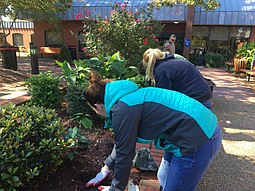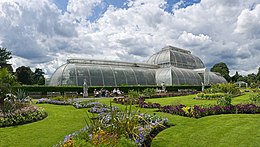Horticultural therapy
This article may need to be rewritten to comply with Wikipedia's quality standards. (May 2024) |
Horticultural therapy (also known as garden therapy[1] or social and therapeutic horticulture) is defined by the American Horticultural Therapy Association (AHTA) as the engagement of a person in gardening and plant-based activities, facilitated by a trained therapist, to achieve specific therapeutic treatment goals.[2]

History[edit]
The first modern documentation of horticulture being used as a treatment for mental health purposes was in the 1800s. Dr. Benjamin Rush was the first to suggest that field labor in a farm setting helped attain positive outcomes for clients with mental illness.[3] This discovery lead many hospitals in the western world to begin using horticulture as a means to start therapeutically treating patients with mental health and developmental disabilities. In 1817, the Asylum for Persons Deprived of Their Reason, now known as Friends Hospital, constructed an environment with landscaping, paths and a park atmosphere in effort to assist patients in their recovery. In 1879 Friends Hospital built the first greenhouse that was used for therapy.[4] Post World War 1 horticultural therapy was used to help servicemen rehabilitate, in the 1940s garden club members brought garden activities to the servicemen and in 1960 the first published book on horticultural therapy was written.[5] The first degree in horticultural therapy was established in 1972.[5]
In 1973 the Council for Therapy and Rehabilitation through Horticulture (NCTRH) was established by a group of horticulture therapy professionals. In 1988, they changed their name to the American Horticulture Therapy Association (AHTA) which they are still called today.[6]
Today, horticultural therapy is practiced in many countries and area in the world, such as in Japan, Korea, Hong Kong, the United Kingdom, Germany, Italy, India and Sweden.
Types of Treatment[edit]
Goals and types of treatment vary depending on the facility using horticultural therapy. Institutions from schools and nursing homes to prisons utilize horticultural therapy to meet therapeutic needs. Each one of these facilities have different types of horticultural therapy, each with their own individual forms of treatment.[7] Fundamentally horticultural therapy can be divided into three types of programming: Vocational, therapeutic, and social.[8]
Vocational Horticultural Therapy[edit]
Vocational Horticultural Therapy is intended to teach skill and enhance behaviors that can be used in a job or workplace.[8] People undergoing vocational therapy can learn skills involving greenhouses, vegetable gardening, tree and shrub care, as well as learn about plant production, sales and services.[8] Activities vocational therapy teaches consists of how to repot, water, and move plants within their space. Learning the basic knowledge of their plants root system and the care different plants need is taught at their own pace.[8] Ultimately aimed at employment, vocational horticulture therapy teaches people how to grow and work with plants while also learning the benefits of supporting themselves mentally and financially.

Therapeutic Horticultural Therapy[edit]
Therapeutic Horticultural Therapy has its focus on medical and illness recovery.[8] The central belief that therapeutic horticulture therapy revolves around is that being in nature has restorative properties.[citation needed] Therapeutic horticulture might be used to try and improve physical activity, social skills and engagement.[8] Activities encompassed by therapeutic horticulture vary widely, some activities include: repetitive actions such as digging and watering, making observations about plant growth and change, relating plant life cycle to human life, and starting seeds.
A systematic review and meta-analysis of research comparing horticultural therapy with usual care and other non-pharmacological interventions for individuals with dementia found that participating in certain types of horticultural therapy activities appeared to improve cognitive functioning, agitation, positive emotion and engagement scores when compared to usual care and other non-pharmacological interventions.[9]
Social Horticultural Therapy[edit]
Social Horticultural Therapy is focused on leisure activity and enhancement of life quality.[8] Unlike therapeutic horticultural therapy, social horticultural therapy is more likely to be activity based.[8] Social Horticulture therapy works to create a community that focuses on plant growth and teaches self-reliance all while providing a support system.[citation needed]
Another element of social horticultural knowledge and expertise is to advise patients and the general public how different herbs and spices can be added to their meals to give flavour and to cure minor ailments. If the varies herbs and edible food crops and plants are planted in their gardens. The patient and or their family can go and pick the varies herbs to add to their meals. Carers with horticultural knowledge and expertise can advise their patients and their families which herbs can be used for different dishes, and advise what other ingredients would work well with these dishes.[citation needed]
See also[edit]
References[edit]
- ^ "Garden Therapy: the benefits of an outdoor life". Corradi Outdoor Living Space. Corradi Srl. March 2019. Retrieved 10 May 2022.
- ^ "American Horticultural Therapy Association Definitions and Positions" (PDF). Archived from the original (PDF) on 2013-09-08.
- ^ Rush, Benjamin (1830). "Medical inquiries and observations upon the diseases of the mind, 4th ed". doi:10.1037/11843-000.
{{cite journal}}: Cite journal requires|journal=(help) - ^ UHSAdmin (2019-02-18). "History of Friends Hospital | Psychiatric Hospital | Philadelphia, PA". Friends Hospital | Philadelphia, PA. Retrieved 2020-04-19.
- ^ a b "American Horticultural Therapy Association". 2007.
- ^ "Mission & Vision". American Horticultural Therapy Association. Retrieved 4 July 2019.
- ^ "What is Social Therapeutic Horticulture?". Thrive. Retrieved 2019-11-17.
- ^ a b c d e f g h Simson, Sharon Pastor, Hrsg.. (2007). Horticulture as therapy : principles and practice. Food Products Press. ISBN 978-1-56022-279-8. OCLC 916655353.
{{cite book}}: CS1 maint: multiple names: authors list (link) - ^ Zhao, Yajie; Liu, Yang; Wang, Zhiwen (July 2022). "Effectiveness of horticultural therapy in people with dementia: A quantitative systematic review". Journal of Clinical Nursing. 31 (13–14): 1983–1997. doi:10.1111/jocn.15204. ISSN 0962-1067. PMID 32017241. S2CID 211025901.
